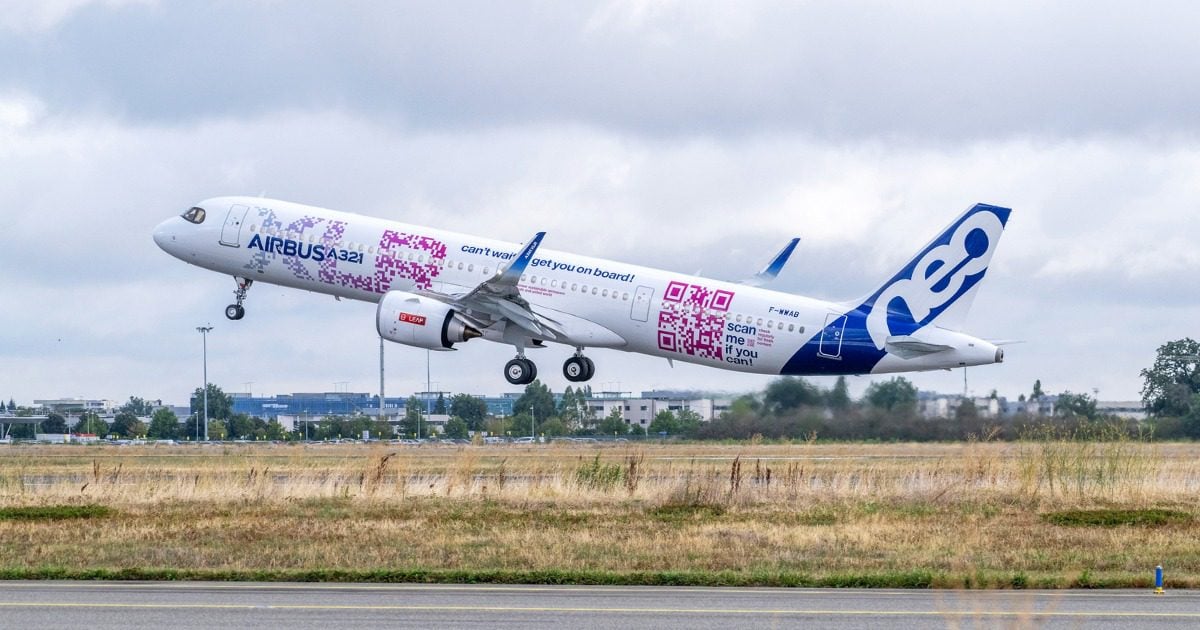
377578575 695796942577491 4470058149491880217 n
Airbus guides to “around 800” commercial deliveries for 2024, up from 735 aircraft in 2023. While supply chain constraints impose limitations, the airframer thinks it has found a “sweet spot” between what suppliers can handle and what Airbus requires. FY24 deliveries will include the first A321XLRs, although Airbus said today that entry into service will slip by one quarter to Q3.
With 800 projected deliveries, Airbus would be on par with 2018 levels but is still below the record of 863 in 2019. The higher deliveries expected for 2024 reflect gradual production ramp-ups of the various programs.
While not offering interim production rates since last summer, CEO Guillaume Faury reiterated during the earnings call that the A320neo family is “progressing well” towards 75 aircraft per month in 2026. That same year, the A220 should reach 14 per month while work is ongoing on the financial maturity of the program, with the A350 set to reach 10 per month. The A330 will reach four per month later in 2024.
The ability to ramp up comes from the supply chain, which confirmed in 2023 that it could keep up with Airbus’ requirements. The A320neo line delivered 571 aircraft: the A220 68, the A350 64, and the A330 32. However, Faury said the supply chain remains “a critical path.”
Limiting factor
Elaborating on this, Faury said: “Over the last two year, the supply chain has been a limiting factor, and we expect it will still pace our production ramp up going forward. This said, we carefully assess and target what I call a “sweet spot”, which is the best balance between demand and the ability of our supply chain to deliver while, of course, maintaining the highest safety standards of our industry. Our plan on 2024 is built on that,” said Faury. The last remark is an indirect reference to the critical situation at Boeing.
Faury added later: “The 800 deliveries is trying to reach a good balance between a very strong demand and the ability of the supply chain to do the ramp up and support an efficient production system. The supply chain is on a critical path. We have a number of critical supplies from certain suppliers and we spent a hell of a lot of time each and every year trying to best-assess the capacity of the supply chain. The ability to reach 800, slightly more or slightly less, is very much linked to the supply chain itself and the deliveries from the supply chain to Airbus. We are at Airbus in 2024 well-sized to do more. We are ahead of the curve when it comes to our production system.”
Looking ahead at the even higher rates for 2026, Airbus has already invested in hardware at production facilities worldwide and invested in people. It hired some 13.600 people last year to bring headcount to 147.893, which Faury said was slightly ahead of what was planned for 2023. This included hiring staff from sub-contractors and bringing more capabilities in-house. “We think that the 2024 plan and where we are today on the ramp-up is consistent with our targets for 2026. The main enablers are in place. The risks are more external factors. That’s why we are putting a lot of priority on understanding the bottlenecks before it becomes a drag on the ramp-up.”
Faury said that rate 75 is expected to remain at that rate for quite some time, and no further rate increases are expected.
2023 results
Airbus can look back on a strong year, receiving net orders for 2.094 aircraft, bringing the backlog to 8.598 aircraft. Of this, 84 percent is the A320neo family, with the A220 and A350 each at 7 percent and the A330 at 2 percent.
The high number of deliveries pushed consolidated revenues to €65.4 billion, up 11 percent over €58.8 billion in FY22. Of this, €47.8 billion is for commercial aircraft, up 15 percent from €41.2 billion in the previous year. Helicopters and Defence & Space also contributed positively to revenues.
Yet, the consolidated net income was down 11 percent to €3.8 billion from €4.2 billion. EBIT Reported was down 14 percent to €4.6 billion from €5.3 billion, while EBIT Adjusted was up 4 percent to €5.8 billion from €5.6 billion. These results include net adjustments of €1.2 billion, of which €1.0 billion in a dollar working capital mismatch and balance sheet revaluations of aircraft orders and delivery dates. EBIT Adjusted includes a €0.6 million charge for Defence & Space on certain space programs, a €41 million charge on the A400M multirole transport aircraft, and €89 million for the transformation of Aerostructures.
New Chief Financial Officer Thomas Töppfer noted that the FY22 results included positive non-recurring impacts from retirement obligations and compliance-related topics partly offset by the impact of the international sanctions on Russia. Free cash flow before mergers and acquisitions and customer financing was down by 6 percent to €4.4 billion.
Looking more closely at Commercial Aircraft, EBIT was down by 25 percent to €3.6 billion, with EBIT Adjusted up 5 percent to €4.8 billion.
Airbus ended 2023 with €10.7 billion in net cash, liquidity at €33.3 billion, and €14.6 billion in gross debt. The OEM proposes a €1.80 dividend per share and a special dividend of €1.0. In its FY24 outlook, Airbus guides an EBIT Adjusted of between €6.5 and €7.0 billion free cash flow before customer financing of €4.0 billion. From now on, FCF excludes M&A.
Investing in a new single-aisle aircraft
Last year, Airbus invested €3.3 billion in R&D, up from €3.1 billion in 2022. R&D spending on various “technology bricks” will continue in the coming years as Airbus works on the next-generation single-aisle aircraft that will become the successor of the A320neo family in the second half of the next decade. This new platform will be a short to medium-range aircraft that can run on 100 percent sustainable aviation fuels (SAF). “It is at the front and center of our decarbonization strategy for 2050,” said Faury.
At the same time, the airframer continues to invest in the ZEROe hydrogen program that should enable the entry into service of the first model at the low end of the market by the mid-30s. Recent successful tests with the hydrogen fuel-cell system fuel optimism that this technology is possible. Airbus is still evaluating the two streams of direct burn of hydrogen and fuel-cell technology and wants to test them first. The selection of the propulsion system in 2025-2026 will be the next “maturity gate.” Faury added that getting the regulatory framework and hydrogen ecosystem ready is as important as developing the aircraft itself.
Airbus will also continue to invest in and look for potential mergers and acquisitions in the digital scene, with the proposed acquisition of ATOS being just one example. Faury said that digital is a key priority in developing next-generation civil and military aircraft as it builds on the digital design, manufacturing, and services (DDMS) approach introduced with the A350.
Slight XLR delay
As mentioned, Airbus said that entry into service of the A321XLR has slipped from Q2 to Q3. Faury added that this is only a slight delay that won’t affect the delivery schedules of most customers. The first production aircraft, believed to be for Aer Lingus, has been in final assembly in Hamburg since December. Airbus has 550 XLRs in the backlog.
Faury said the A321XLR is in the final phase of the certification flight testing and document finalization. When it enters service, the XLR will meet its advertised range of 8.700 kilometers/4.700 nautical miles, despite modifications required by EASA to make the rear-center tank safer and more robust.
(This story is Richard Schuurman’s final contribution to AirInsight)
Views: 11




